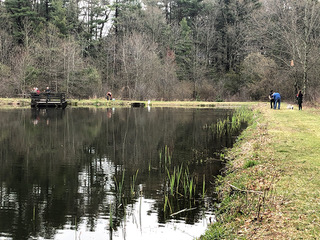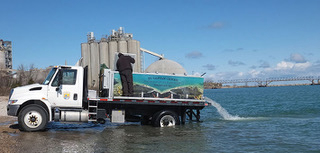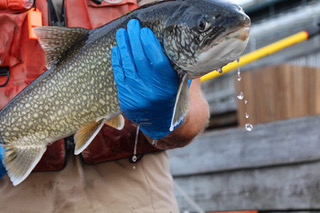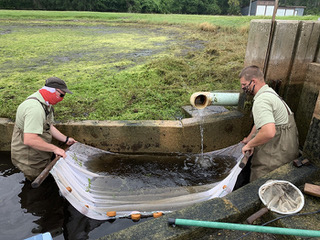Editor’s Note: This feature was supplied to us by the USFWS.

Fishing is popular these days. Photo by USFWS
|
As the country begins to reopen, responsible outdoor recreation is needed to support our nation’s social and economic recoveries. Fishing is one activity that may be enjoyed alone or with others while keeping a responsible social distance apart. It also supports local businesses such as tackle shops, boat rentals, guide services, motels, and local diners and restaurants.
Visiting a National Fish Hatchery System (NFHS) facility is an ideal way to spend quality time outdoors because many offer picnic tables, on-site fishing opportunities, walking paths, walking tours, and more. And don’t be surprised if you hear the joyous sounds of small children as they throw fish food into the water and see the fish swim to the surface for their own picnic.
VISIT: Find a Hatchery Near You
For almost 150 years, NFHS staff has worked collaboratively with tribes, states, landowners, partners and stakeholders to promote and maintain healthy, self-sustaining populations of fish and other aquatic species. They work with almost 100 fish species and in 2019, NFH staff stocked more than 109 million fish for recreational public fishing.
In years past, stocking lakes, rivers and streams could be challenging, but never more so than during the COVID-19 pandemic. Hatchery staff developed new methods to stock hatchery-raised fish, while staying safe.
Many factors determine when fish may be released from a hatchery into the wild. They must be large enough to thrive on their own, released before they outgrow the hatchery, and the water temperature between the hatchery and the open water must be similar. Overcrowding can cause stress and disease, which will jeopardize the stocking program, so careful planning is crucial, and timing is everything. If a stocking season is missed, there will be a shortage of recreational fish for a few years, which would reduce the number of fishing opportunities and drastically affect local economies.
Spring is an active time to stock fish, and it was spring when the country went into isolation. At many hatcheries, if the spring stocking were not completed, the fish would perish and that was not an option for the hatchery staff. While working within the Centers for Disease Control and Prevention guidelines, staff found ways to keep the hatcheries operating seven days a week, volunteered for difficult assignments, altered their work schedules, and reached out to partners to assist with work needed to stock healthy fish and enhance outdoor recreation for the American public. Here are a few examples:




In Massachusetts, staff at North Attleboro National Fish Hatchery found themselves with extra brook trout after community fishing events were canceled. They stocked a pond on the hatchery with 1,000 nice-sized, catchable trout and transferred 6,000 to Rhode Island’s Lafayette State Fish Hatchery.
North Attleboro Hatchery then opened their pond for fishing and posted guidance about social distancing. Anglers kept a safe distance apart and the response was overwhelmingly positive from the local community.
“On behalf of all the stuck-at-home-parents, allow me to commend your efforts and your sincere attempt to make life a little better in these trying times. You provided kids, and some bored adults, an opportunity to get outdoors, take in the beauty of nature, and possibly catch a trout – it is just what most doctors would prescribe. Your genuine compassion, for all that these times have plagued us with, is a blessing. You have brought smiles, muddy feet, and sincere joy to a few of my grandkids. We were able to get outdoors, have a picnic, be a part of nature and even laugh!!!! You, and all of your associates, are awesome and deserve many thanks! -- message one grandfather wrote to the hatchery manager”

Workers harvest striped bass. Photo by USFWS
|
In the Southeast, national and state fish hatchery staff overcame multiple challenges to populate Lake Talquin in Florida with striped bass. Lake Talquin is Florida’s primary source of striped bass production and stocking, and the Gulf striped bass restoration program is an important recreational, economical, and cultural fishery program.
Typically, state biologists use electro-fishing boats to collect mature fish for spawning in national and state fish hatcheries. But, Florida Fish and Wildlife Conservation Commission biologists were unable to get out this spring because of the pandemic, and Georgia Department of Natural Resources biologists were hampered by high water events that made it unsafe to launch boats. Fortunately, the Alabama Department of Conservation and Natural Resources biologists had a very productive brood collection year and Marion State Fish Hatchery had a productive season
But how to get striped bass fingerlings (fish less than a year old) from Marion to Lake Talquin, which is about 300 miles and more than a 5-hour drive?
Staff at Warm Springs National Fish Hatchery in Georgia sent a truck, trailer and a 500-gallon hauling tank to Marion, where it was filled with more than 75,000 striped bass fingerlings. Staff from Welaka National Fish Hatchery in Florida drove to Eufaula, Alabama, (310 miles) to meet the Warm Springs staff. In an Alabama downpour, staff transferred the trailer from the Warm Springs truck to the Welaka truck, and Welaka staff continued to Lake Talquin and released the 75,000 fingerlings.
Fourteen National Fish Hatcheries in the Pacific Northwest released more than 32 million juvenile salmon and steelhead to support regional commercial and tribal harvests and recreational angling opportunities.
In the White Mountains of east-central Arizona the Alchesay-Williams Creek National Fish Hatchery Complex consists of two hatcheries 25 miles apart on the Fort Apache Indian Reservation. . All fish cultured at the two hatcheries are stocked only into tribal waters across Arizona and New Mexico as a Tribal Trust responsibility of the Service to the sovereign Native American nations.
During the spring, many of the reservations were closed, but the tribes still requested fish be stocked for fishing later in the year. Working closely with the tribes to either have an escort or a letter of admittance to enter reservation lands, hatchery staff worked tirelessly to stock trout, an economic driver for the tribes.
In total, staff stocked 433,000 fish to 11 tribal waterways or sites and logged almost 15,000 road miles in 63 fish stocking trips. In addition, the staff cared for more than 1,400,000 fish and fish eggs.
The Willow Beach Marina area on the Lake Mead National Recreation Area, next to Willow Beach National Fish Hatchery is a fishing spot for Las Vegas residents and many who live in Arizona. Since it is located next to a national park that remained open to the public, fishing here has become more popular, and that meant staff had to continually stock fish. The dedicated staff of this hatchery offered to work split schedules in order to stay safe, while keeping their work flowing.
In Texas, Inks Dam National Fish Hatchery raise catfish to stock tribal lands. Even though it was the Memorial Day holiday weekend, one staffer volunteered to drive and sleep in a semi-truck specially designed to haul fish. Sleeping quarters in the truck were needed because some of the smaller towns were closed to those passing through and lodging could not be found.
The Service is deeply grateful for continued support from and collaboration with our state, and other, partners. Strong partnerships help us accomplish shared conservation goals to benefit current and future generations of Americans.
Fishing and other aquatic-based recreational opportunities are multi-cultural, multi-generational experiences that bring substantial economic returns to local communities, provide jobs, and lead to improved quality of life for the American people. If you would like information on how and where to fish, visit the Recreational Boating & Fishing Foundation’s Take Me Fishing or the Service’s Let's Go Fishing. Catch the Fun! website.